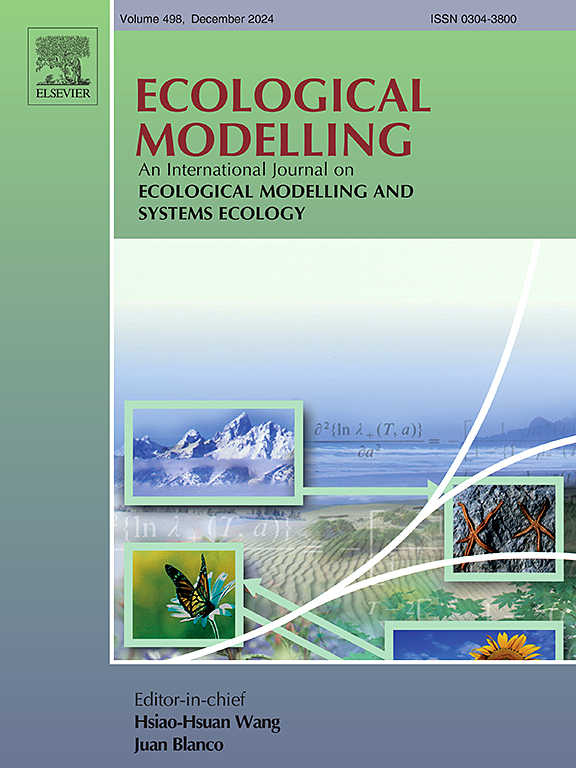欧洲鹤类迁徙的高分辨率时空预测
IF 2.6
3区 环境科学与生态学
Q2 ECOLOGY
引用次数: 0
摘要
本文介绍了三种不同的鸟类迁徙预测模型。它们都是基于物种个体的高时空分辨率(千米、15 分钟-小时)模型,是对现有基于雷达的迁徙预报模型的补充。这些模型的复杂程度各不相同,使用 GPS 跟踪的位置、飞行方向和速度以及/或风力数据来预测迁徙速度和方向。我们的目的是对预测性能进行定量评估,并评估在不同范围内哪些指标能提高预测效果。我们利用普通鹤在春季和秋季迁徙期间的 GPS 轨迹,通过交叉验证对模型进行了测试。结果表明,飞行速度和方向的记录提高了短距离(2 小时)预报的准确性。在飞行高度上添加风力数据可持续改善整个范围内的预测,尤其是在预测速度方面。方向预测受风向数据的影响较小,因为鹤类在迁徙过程中大多会补偿风的漂移。春季的迁徙比秋季更难预测,因此春季的飞行速度和方向误差更大。我们还发现,热翱翔、滑翔和拍击等飞行行为的组合会引起飞行速度和方向的变化,从而使预测变得复杂。事实证明,将这些行为纳入飞行优化模型具有挑战性,甚至会导致春季速度预报出现明显偏差。我们的结论是,飞行速度是最难预测的参数,而飞行方向则是这些模型实际应用中最关键的参数。这些应用可以是防止航空或风力涡轮机中的鸟类撞击,也可以是公众参与鸟类迁徙。本文章由计算机程序翻译,如有差异,请以英文原文为准。
High-resolution spatiotemporal forecasting of the European crane migration
In this paper we present three different models to forecast bird migration. They are species-specific individual-based models that operate on a high spatiotemporal resolution (kilometres, 15 min-hours), as an addition to radar-based migration forecast models that currently exist. The models vary in complexity, and use GPS-tracked location, flying direction and speed, and/or wind data to forecast migration speed and direction. Our aim is to quantitatively evaluate the forecasting performance and assess which metrics improve forecasts at different ranges. We test the models through cross-validation using GPS tracks of common cranes during spring and autumn migration. Our results show that recordings of flight speed and direction improve the accuracy of forecasts on the short range (<2 h). Adding wind data at flight altitude results in consistent improvements of the forecasts across the entire range, particularly in the predicted speed. Direction forecasts are less affected by adding wind data because cranes mostly compensate for wind drift during migration. Migration in spring is more difficult to forecast than in autumn, resulting in larger errors in flight speed and direction during spring. We further find that a combination of flight behaviours – thermal soaring, gliding, and flapping – complicates the forecasts by inducing variance in flight speed and direction. Fitting those behaviours into flight optimisation models proves to be challenging, and even results in significant biases in speed forecasts in spring. We conclude that flight speed is the most difficult parameter to forecast, whereas flight direction is the most critical for practical applications of these models. Such applications could e.g., be prevention of bird strikes in aviation or with wind turbines, and public engagement with bird migration.
求助全文
通过发布文献求助,成功后即可免费获取论文全文。
去求助
来源期刊

Ecological Modelling
环境科学-生态学
CiteScore
5.60
自引率
6.50%
发文量
259
审稿时长
69 days
期刊介绍:
The journal is concerned with the use of mathematical models and systems analysis for the description of ecological processes and for the sustainable management of resources. Human activity and well-being are dependent on and integrated with the functioning of ecosystems and the services they provide. We aim to understand these basic ecosystem functions using mathematical and conceptual modelling, systems analysis, thermodynamics, computer simulations, and ecological theory. This leads to a preference for process-based models embedded in theory with explicit causative agents as opposed to strictly statistical or correlative descriptions. These modelling methods can be applied to a wide spectrum of issues ranging from basic ecology to human ecology to socio-ecological systems. The journal welcomes research articles, short communications, review articles, letters to the editor, book reviews, and other communications. The journal also supports the activities of the [International Society of Ecological Modelling (ISEM)](http://www.isemna.org/).
 求助内容:
求助内容: 应助结果提醒方式:
应助结果提醒方式:


